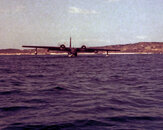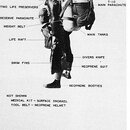Okay, I'll try to answer a few more questions here.@John C. Ratliff
...What about medical assistance that can be administered? I'm "guessing" that PR is mostly used when the distance offshore is out of chopper range. How much and what kind of gear are they prepared to drop? Is the idea to wait for rescue by ship or sub? Do you train and prep for commercial airliners in the water... not that the chances of surviving the crash is very high.
What kind of medical treatment can be administered? Well, we were trained to use most any available medical treatment for trauma, including IVs, drugs, maintaining an airway (up to and including a cricothyroidotomy), and most any medical trauma. We also attended to things like child birth, heat and cold injuries, heart attacks (although at that time we had no ECGs available--cannot say about now). But most of our training was for traumatic injuries.
Is the idea to await rescue by ship or sub? Not necessarily.
This is a short clip of the HC-130 equipped with the Fulton Recovery System. We were trained in its use, but by the time I was in as a PJ we did not actively ride the system anymore. It was used during Apollo to recover film from the Navy ships, for instance, and was man-rated. There are rumors that this system was used in Laos and possibly North Vietnam to extract people from very difficult situations, but I've never confirmed that info. And yes, this Fulton recovery system was featured in a popular James Bond movie in the 1960s or early 1970s, as was the USAF parascuba jump out of a HC-97 portrayed in "Thunderball."
The HU-16B Albatross could land on water, and there were definitely pickups out of Haiphong Harbor in North Vietnam of pilots who were shot down. Here are two citations for the Silver Star:
James E. Pleiman
Silver Star
November 1, 1965
Note the date. Here is the second Silver Star:Citation to accompany the award of the Silver Star to Airman Second Class James E. Pleiman.
Airman Second Class James E. Pleiman distinguished himself by gallantry in connection with military operations against an opposing armed force over North Vietnam on 1 November 1965. On that date, Airman Pleiman was instrumental in effecting the safe and expeditious recovery of a United States Air force RF-101 Pilot from hostile waters in the Gulf of Tonkin. With complete disregard for his safety, and with armed hostile swimmers within one hundred feet of him, Airman Pleiman jumped into the water to assist the pilot. This courageous and aggressive action promulgated against overwhelming odds, resulted in reducing the time the aircraft and crew were exposed to hostile fire. By his gallantry and devotion to duty, Airman Pleiman has reflected great credit upon himself and the United States Air Force.
James E. Pleiman KIA
March 14, 1966
I'll add just a bit more about this story later.The UH-16 was first on station, supported by fixed-wing aircraft. When Westenbarger landed, the Albatross drew artillery and mortar fire from emplacements ashore as well as small-arms fire from sampans headed out to capture the downed F-4 crewmen. As the UH-16 crew, with A1c Pleiman in the water, attempted to assist Major Peerson aboard, the HU-16 was hit by an artillery shell and exploded in flames, leaving eight men in the water. A Navy SH-3 helicopter from HS-4 was able to pick up Major Peerson before being forced from the area with combat damage. A second SH-3 (also HS-4), operating under cover of supporting fixed-wing aircraft, picked up Bryant, Westenbarger, Hall, and Jackson, and a Navy UH-2 from HC-2 later picked up Captain Price. The rescued HU-16 crewmen stated that A1c Hilton was killed before the Albatross was abandoned and that A1c Pleiman was floating face-down in the water afterwards. Neither Hilton nor Pleiman were recovered. James Pleiman, A1C, Air Force, Russia OH, 24Mar66 06E007 - The Virtual Wall®
SeaRat
Attachments
Last edited:





